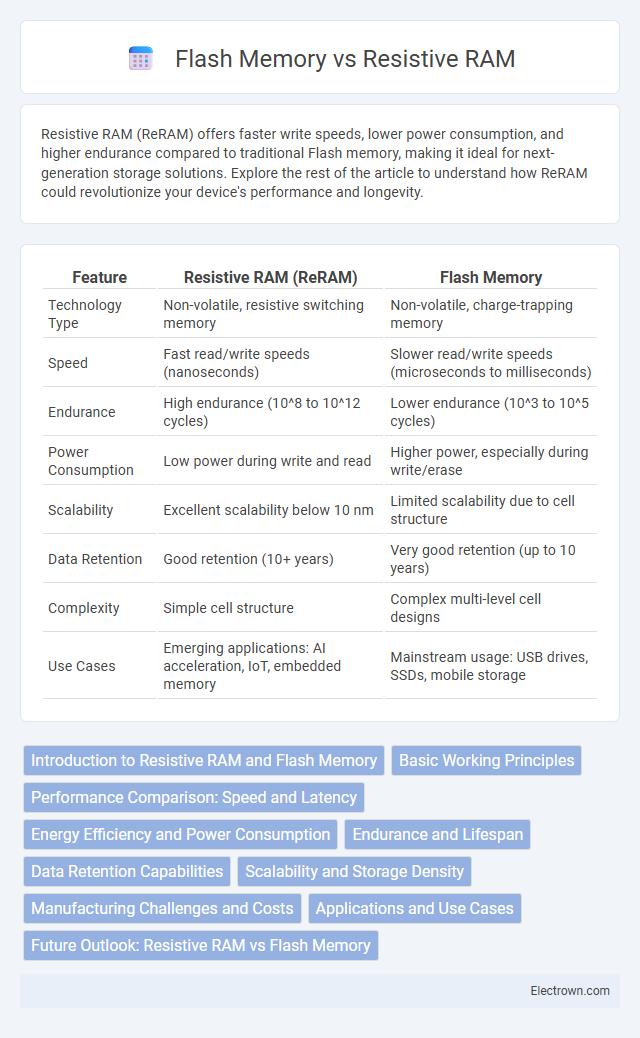Resistive RAM (ReRAM) offers faster write speeds, lower power consumption, and higher endurance compared to traditional Flash memory, making it ideal for next-generation storage solutions. Explore the rest of the article to understand how ReRAM could revolutionize your device's performance and longevity.
Table of Comparison
| Feature | Resistive RAM (ReRAM) | Flash Memory |
|---|---|---|
| Technology Type | Non-volatile, resistive switching memory | Non-volatile, charge-trapping memory |
| Speed | Fast read/write speeds (nanoseconds) | Slower read/write speeds (microseconds to milliseconds) |
| Endurance | High endurance (10^8 to 10^12 cycles) | Lower endurance (10^3 to 10^5 cycles) |
| Power Consumption | Low power during write and read | Higher power, especially during write/erase |
| Scalability | Excellent scalability below 10 nm | Limited scalability due to cell structure |
| Data Retention | Good retention (10+ years) | Very good retention (up to 10 years) |
| Complexity | Simple cell structure | Complex multi-level cell designs |
| Use Cases | Emerging applications: AI acceleration, IoT, embedded memory | Mainstream usage: USB drives, SSDs, mobile storage |
Introduction to Resistive RAM and Flash Memory
Resistive RAM (ReRAM) is a non-volatile memory technology that stores data by changing the resistance of a material, offering faster write speeds and improved endurance compared to traditional Flash memory, which relies on charge storage in floating-gate transistors. Flash memory remains widely used for data storage in SSDs, USB drives, and memory cards due to its established manufacturing processes and cost-effectiveness. Your choice between ReRAM and Flash memory depends on the need for speed, durability, and energy efficiency in applications such as embedded systems or high-performance computing.
Basic Working Principles
Resistive RAM (ReRAM) operates by changing the resistance of a material to store data, leveraging the formation and rupture of conductive filaments within a metal oxide layer. Flash memory stores data by trapping electrons in a floating gate transistor, altering its threshold voltage to represent binary information. Understanding these basic working principles helps you choose the right non-volatile memory technology for speed, durability, and power efficiency in your applications.
Performance Comparison: Speed and Latency
Resistive RAM (ReRAM) offers significantly faster write and read speeds compared to Flash memory, with latency measured in nanoseconds versus microseconds for Flash. ReRAM's low latency is enabled by its simple resistive switching mechanism, allowing near-instantaneous data access and improved endurance under high write cycles. This performance advantage makes ReRAM highly suitable for applications requiring rapid data processing and frequent memory updates.
Energy Efficiency and Power Consumption
Resistive RAM (ReRAM) demonstrates significantly lower power consumption compared to Flash memory due to its non-volatile nature and faster switching speeds, which reduce the energy required during read/write cycles. Your devices benefit from ReRAM's enhanced energy efficiency, making it ideal for applications demanding low power usage and longer battery life. Unlike Flash memory, ReRAM requires minimal voltage for operation, contributing to reduced heat generation and improved overall device performance.
Endurance and Lifespan
Resistive RAM (ReRAM) offers significantly higher endurance compared to traditional Flash memory, with cycle counts typically reaching up to 10^12, whereas Flash memory endures around 10^4 to 10^6 program/erase cycles. This enhanced durability makes ReRAM particularly suitable for applications requiring frequent write operations and extended lifespan. Moreover, ReRAM's faster write speeds and lower power consumption contribute to improved device longevity and reliability in high-performance computing environments.
Data Retention Capabilities
Resistive RAM (ReRAM) offers significantly improved data retention capabilities compared to traditional Flash memory, maintaining stored information for over 10 years at high temperatures exceeding 85degC. Flash memory experiences data degradation and limited retention times due to charge leakage in its floating-gate or charge-trap structures, often requiring data refresh cycles. ReRAM's non-volatile resistance switching mechanism enables superior endurance and stability, making it well-suited for long-term data storage in harsh environments.
Scalability and Storage Density
Resistive RAM (RRAM) offers superior scalability compared to Flash memory due to its simpler cell structure and lower power consumption, enabling higher storage density on smaller chips. Flash memory faces limitations in scaling as its multi-level cell design becomes increasingly complex and prone to wear at smaller process nodes. If you seek future-proof, high-density storage solutions, RRAM stands out by supporting greater data retention and faster write speeds within compact form factors.
Manufacturing Challenges and Costs
Resistive RAM (ReRAM) faces significant manufacturing challenges due to its complex material integration and precise filament formation, which increase production costs compared to mature Flash memory technology. Flash memory benefits from well-established fabrication processes and economies of scale, resulting in lower manufacturing expenses and higher yields. Your choice between Resistive RAM and Flash should weigh these cost differences alongside performance requirements.
Applications and Use Cases
Resistive RAM (ReRAM) offers faster write speeds and higher endurance, making it ideal for applications in embedded systems, Internet of Things (IoT) devices, and neuromorphic computing where low power and high reliability are critical. Flash memory remains the standard for mass storage solutions such as SSDs, USB drives, and memory cards due to its cost-effectiveness and large capacity. Emerging ReRAM use cases target real-time data processing and edge computing, where durability and speed outperform traditional Flash memory limitations.
Future Outlook: Resistive RAM vs Flash Memory
Resistive RAM (ReRAM) exhibits significant potential to surpass Flash memory due to its faster write speeds, lower power consumption, and higher endurance, making it ideal for next-generation non-volatile storage solutions. While Flash memory currently dominates the market because of its mature manufacturing processes and cost-effectiveness, scaling limitations and slower write cycles pose challenges for future applications. Emerging innovations in ReRAM materials and integration techniques indicate a growing shift toward ReRAM for applications requiring high-speed, durable, and energy-efficient memory technology.
Resistive RAM vs Flash memory Infographic

 electrown.com
electrown.com